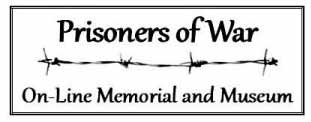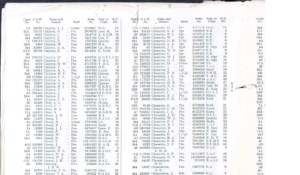Clements, Walter Howard
Sapper Walter Howard Clements
From Paul Howard Clements. 09/10/2023
W H Clements was already a Territorial Army recruit prior to the outbreak of the war, at the time, he was working for P H Smith a reputable builder of Highgrove Street, Reading, [England] as a Builder Decorator & Plumber, living at 24, Whitley Street with his wife Evelyn and 2 daughters Evelyn & Patricia, later his Mother in law and sister in law lived at the same address.
A strange revelation was, when I was amassing the information from Prisoner Questionnaires, was that his brother in law, Frederick John Cook (also a Sapper in the Royal Engineers) gave the address at 24 Whitley Street as a C/O of, was also a POW at Stalag 344 but his report was not as detailed as my fathers.
Father’s basic training being undertaken in Wiltshire. He was called up in January 1939 and joined the 226th Field Company Royal Engineers at Reading, this company joined the 48th Midland Division No 1 and this Division left the UK with the BEF (British expeditionary force) in January 1940 his soldier number was 2069710.
Leaving from Southampton to Bolougne on landing in France and made its way to Belgium. Where it became a part of the Phoney War,from the war diaries they were based at Brugges in Belgium.
The Germans at this time were amassing their troops along the Belgian/French border and using the blitzkrieg tactics overwhelmed the British forces who were pushed back into France, ultimately back to Dunkirk, and its surrounds.
From my research and memory recalls from my father’s discussions where he was captured at Whatou during the battle for Cassel, and on the 30th April 1940 he was captured, in a church yard along with his comrades. (‘snitched on’ [reported] by the locals evidently, he detested them for this.)
There is very little available on the 226th RE except for the War Diary which I am in the process of ordering to determine the retreat back to Cassel).
After being captured, long marches were commonplace for the POWs, and dad’s journey was back into Germany, initially through Domart, St Pol, Bethune, and Seclin in France; Tournai, Renaix, Ninove, St Nicholas in Belgium; Hulst, Walsoorden, in Holland; Wesel, Hemer, and onward distribution to Oflags and Stalags in Germany. and then by cattle trucks shut in for several days and loaded to capacity onto Lambsdorf Upper Silesia Poland. (now called Łambinowice) (this took some 18 days (30th May 1940 until April 1940) extracted from Dad’s capture date to arriving in Ober Silesia Lamsdorf.
During his imprisonment as a POW he was at the following camps :-
Stalag VIIIB, (initial camp 1941} was formerly a barracks during the great war for the German army.
Stalag 344 – VIIIB renamed and upgraded by the Germans to accommodate many more POWs
E3 (Part of Stalag 344) Close to the Hitler Canal and Oder River
E769 (Work detachment E 769 for British prisoners of war, a sub-camp of Stalag 344 at Lamsdorf, was situated inside the grounds of I.G. Farben’s chemical plant at Heydebreck (Blechammer Sud) E 769 was located at a distance of between 400-500 yards from BAB 20
Stalag XIIID was liberated by the US army on 26 April 1945 the first day of efforts to capture Nuremberg by the Americans.
Whilst he was at these camps, he was tasked with labouring duties with the working parties, to the following remote, areas/townships
Poppolau Upper Selisia (Forestry and mining) The work involved felling trees cutting into logs, stripping the bark ready for paper making and props for use in the mines.
E131 & E132 Gogolin Upper Selisia During World War II the Germans established a forced labour camp for Poles and Jews[4] and two labour camps (E131 and E132) of the Stalag VIIIB/344 prisoner-of-war camp for Allied POWs at Łambinowice.[5] About 30 buildings were destroyed in the final stages of the war in 1945.[2] (Limestone Mines) mining limestone for the construction works.
E769 Blechammer (probably on the construction of the Synthetic Oil Factory) The Heydebreck or Blechhammer South is usually used to indicate one of the two chemical plants (the other was just a short distance away at Blechhammer North) constructed by Nazi industrialists, and in particular I.G. Farben, near to the present-day settlement of Stare Koźle (Cosel), where they could exploit the pool of labour supplied by prisoners of war and forced workers. This area was the location of German chemical factories, prisoner-of-war camps, and other forced-labour camps. The factories used bituminous coal in a process to synthesize oil.
It was whilst he was here that many bombing raids, were carried out by the Americans, in close proximity, to where father was working. There are several references to this from the 371st Fighter Group also The US Fifteenth Air Force dropped 7,082 tons of bombs on Blechhammer, with many deaths and injuries resulting amongst the POWs who worked there and coordinates for the camp
A British document makes reference to the fact that it was located inside the “smoke area” of the premises, that is the area which would be covered by a smoke screen in case of pending air raid to render it a invisible to the American bombers.1
On route to XIIID Nuremburg known as the southern route The “southern route”, from Stalag VIIIB (formerly Stalag VIIID) at Teschen (not far from Auschwitz) which led through Czechoslovakia, towards Stalag XIIID at Nuremberg and then onto Stalag VIIA at Moosburg in Bavaria.
It appears that he, departed from the E3 /E769 camps, on 22/01/1945 and was on known as the southern route, one of the long death marches, (basically walking across the length of the old Czechoslovakia but this one was to Nurmburg XIIID , which meant that it took approximately 82 days to complete the horrific journey, in severe wintery conditions January and February 1945 were among the coldest winter months of the 20th century in Europe, with blizzards and temperatures as low as –25 °C (–13 °F), and even until the middle of March, temperatures were well below 0 °C (32 °F). [citation needed] Most of the POWs were ill-prepared for the evacuation, having suffered years of poor rations and wearing clothing ill-suited to the appalling winter conditions.
From E3/e769 it seems that a further march, on the 22 January 1945, when the camp was evacuated and arriving on 13 April 1945 at Xiii-D. and was destined to take the POWs to Stalag VIIA Moosburg which is where they were finally released by the Americans. 29 April 1945 – Stalag VII-A at Moosburg was liberated by Patton’s Third United States Army.
On 4 May 1945 RAF Bomber Command implemented Operation Exodus, and the first prisoners of war were repatriated by air. Bomber Command flew 2,900 sorties over the next 23 days, carrying 72,500 prisoners of war. Flying back in a RAF Dakota (rattling and shaking, like mad) and arriving in England on the 10th May 1945
After arriving back in England and according to the official document Under the Kings Regulations 1940 he was discharged as unfit. (further clarification required on this data needs to be deciphered) He was demobbed in Brighton in 1945.
Walter Howard Clements went to a number of reunions in Streatham, London with fellow POW and extracts from a booklet shows his address as 20 Whitley Street Reading, Berks (his parents address), indicating that he was without doubt imprisoned at camp E3, photographs (showing him in various plays, dressed as a cowboy,) either sent or brought home to his mother/family have on the address sent from Germany E3.
On returning to the UK he set up with my mother sometime in 1945 as detailed in the electoral roles, remaining at this address for several years, until approx. 1957.
Suggest an improvment to this record












Leave a Reply
Want to join the discussion?Feel free to contribute!